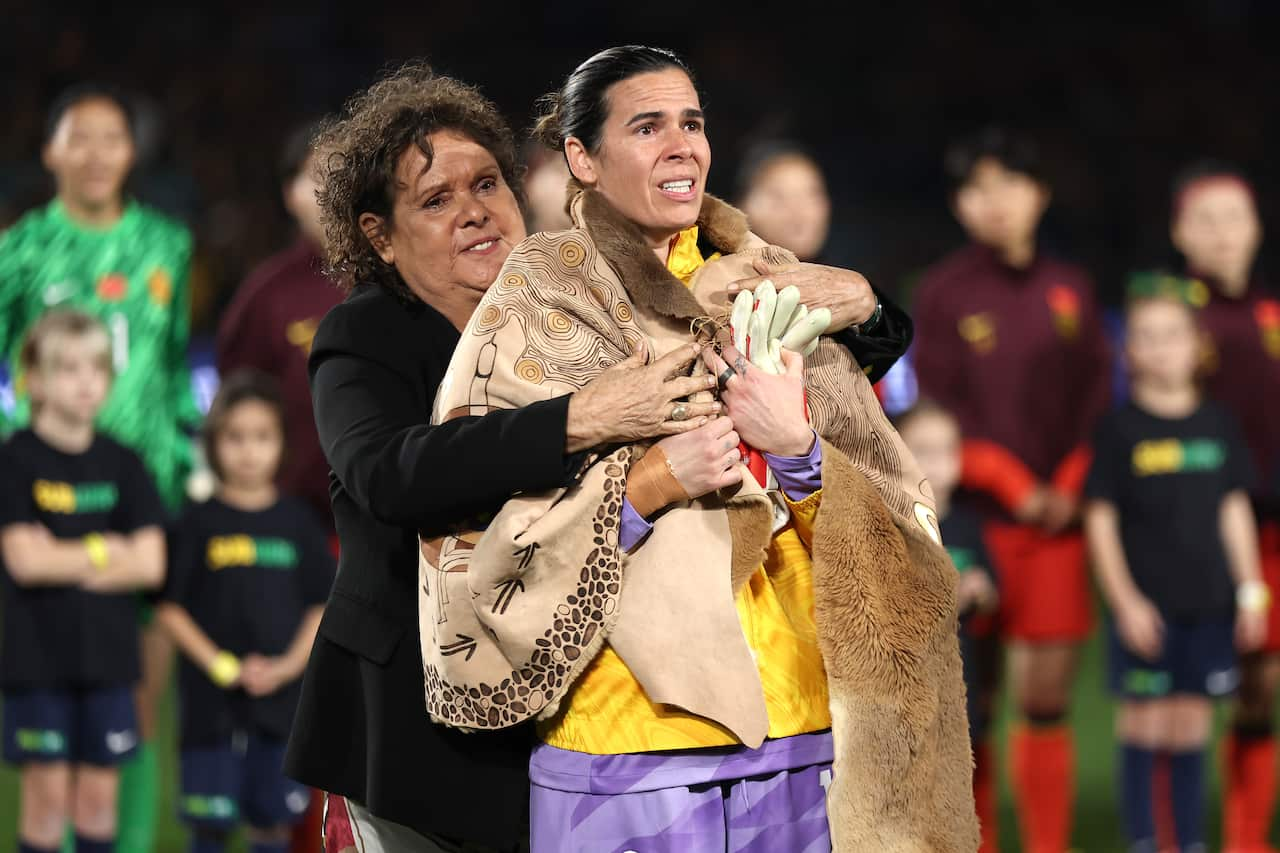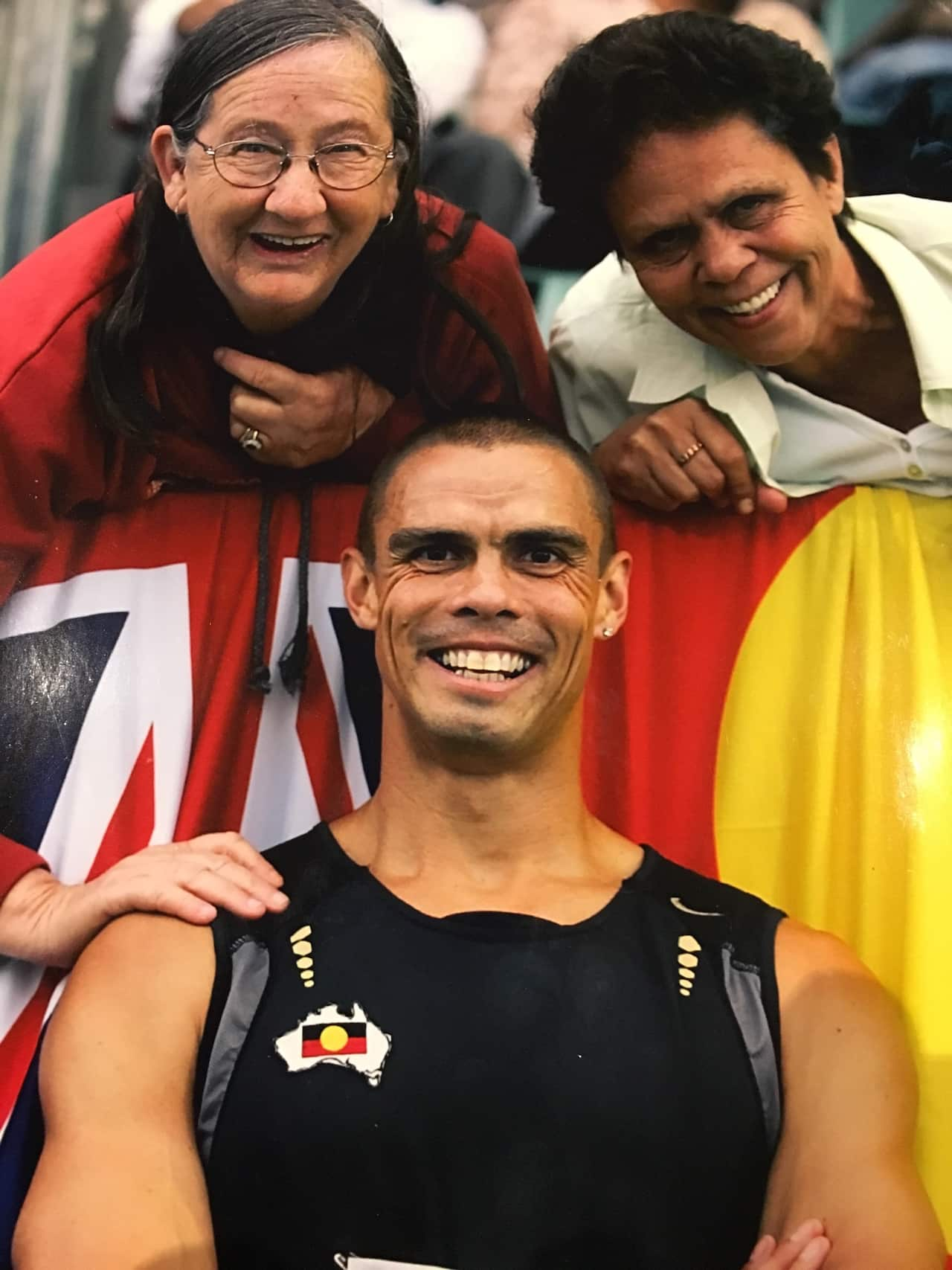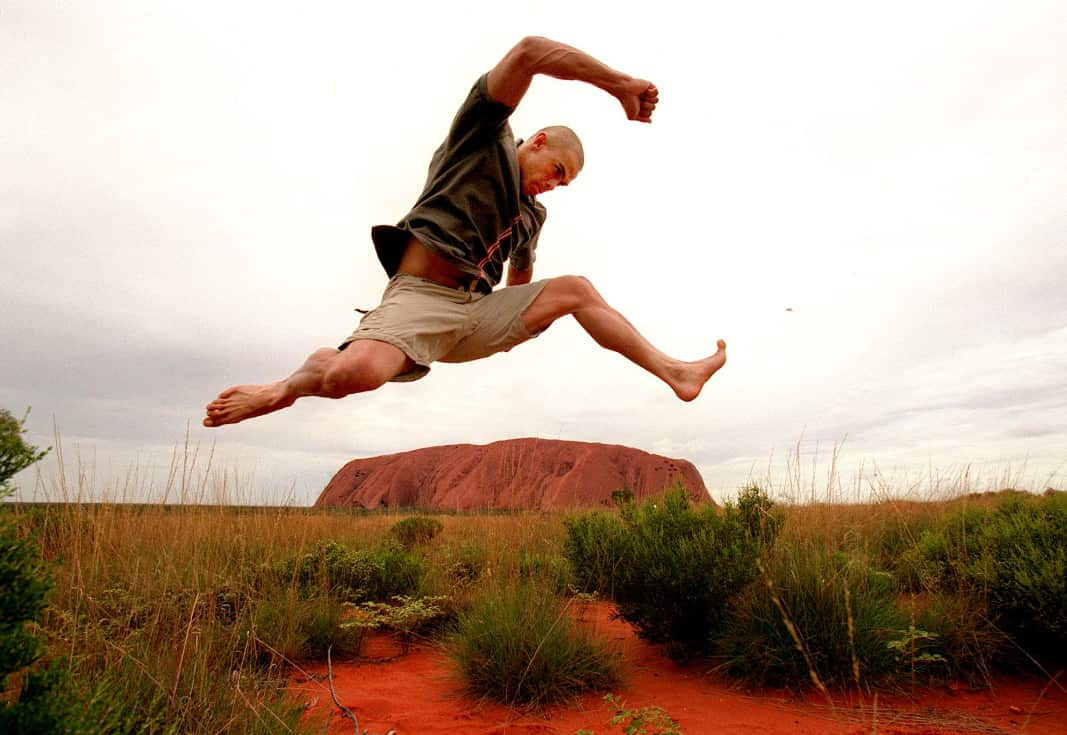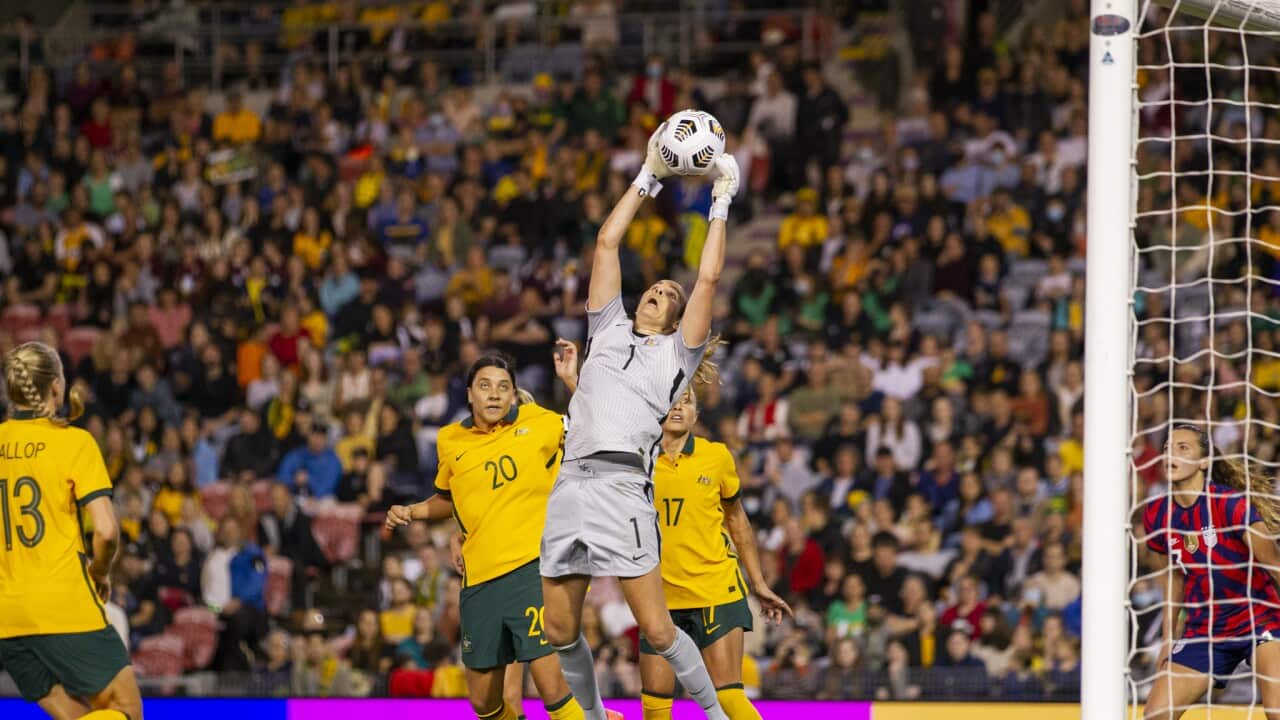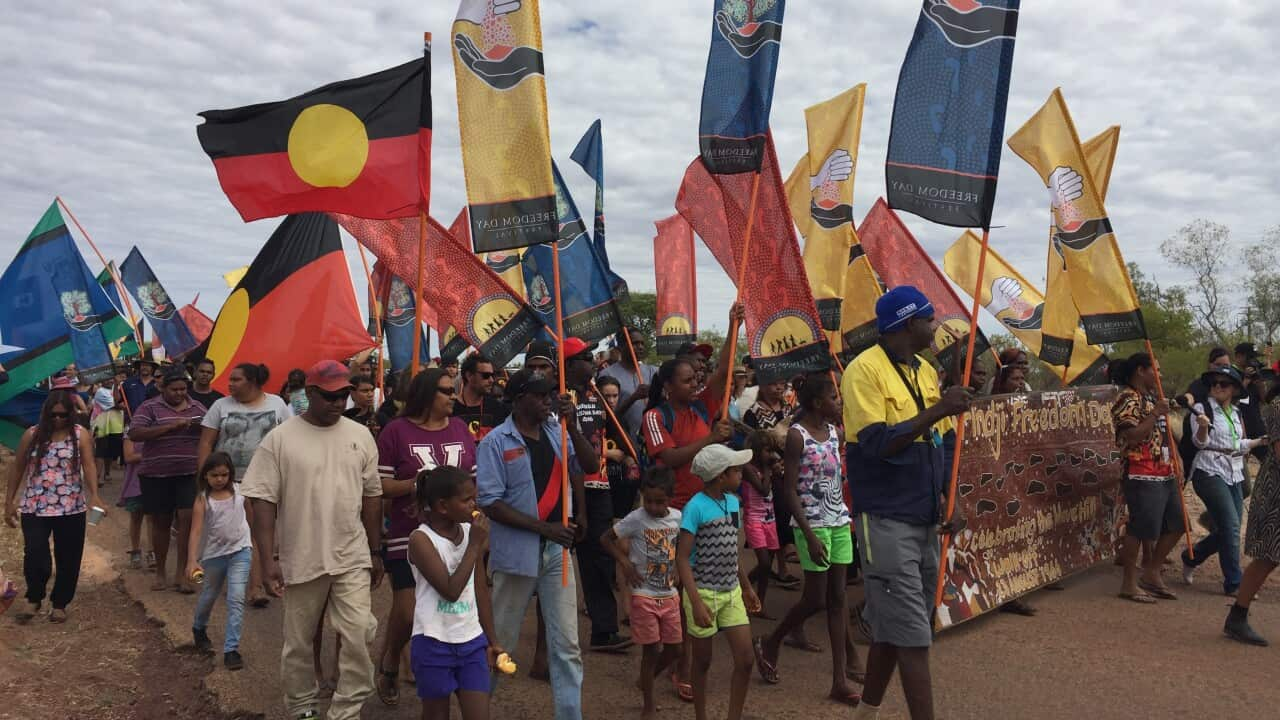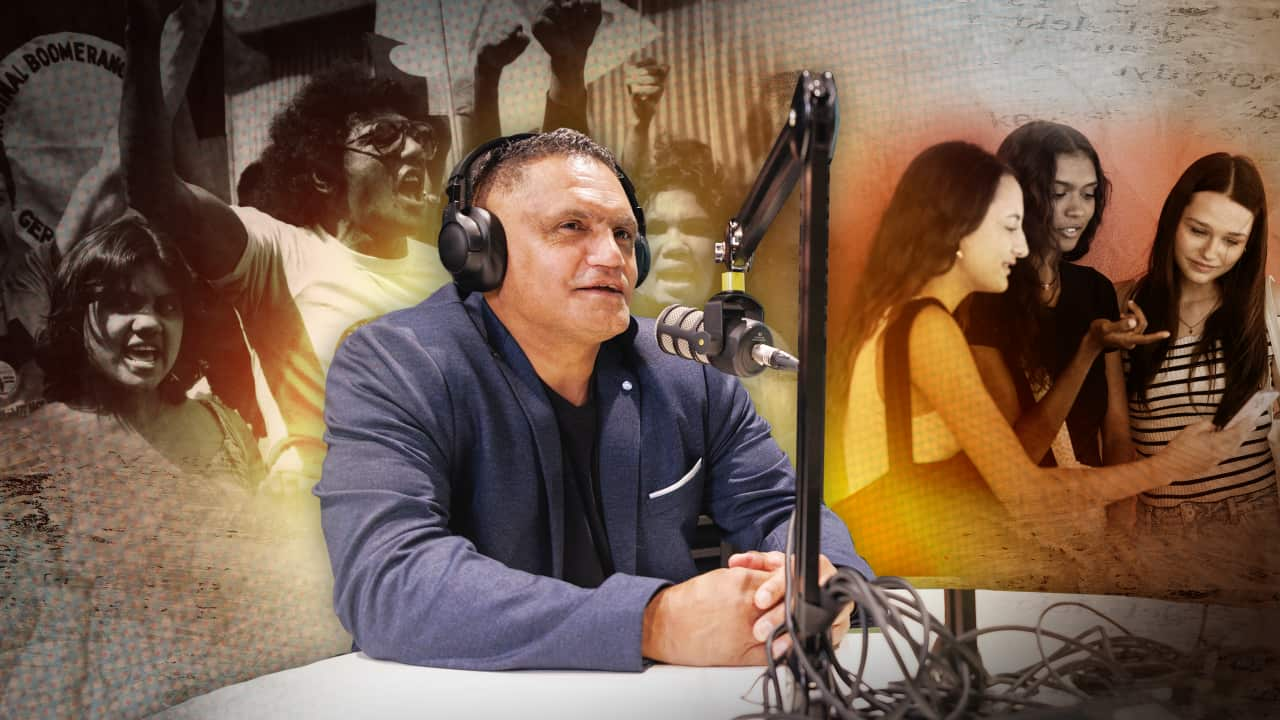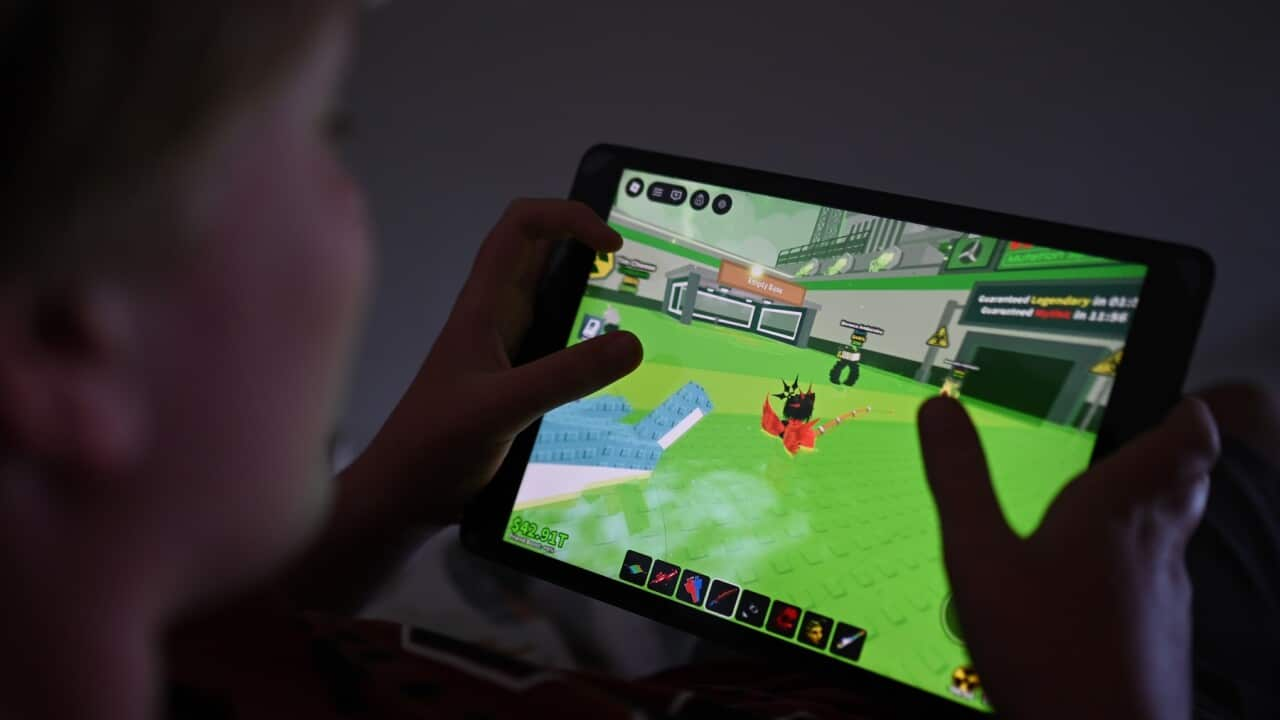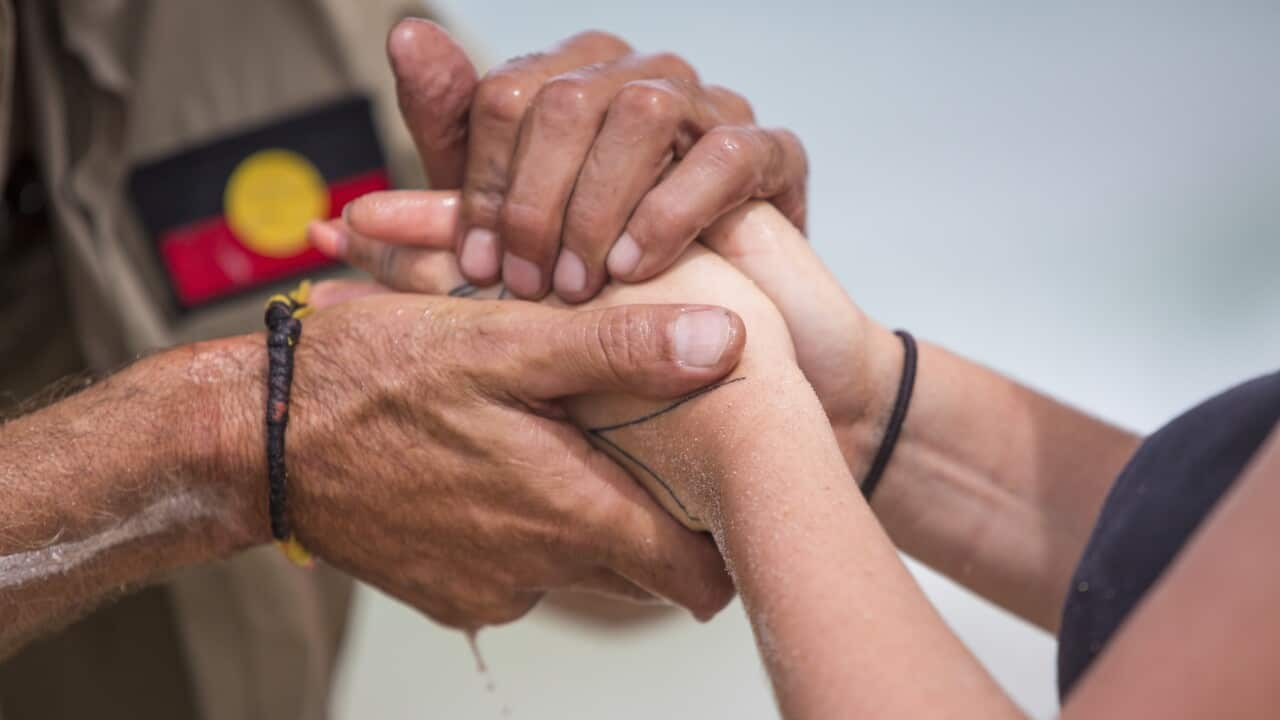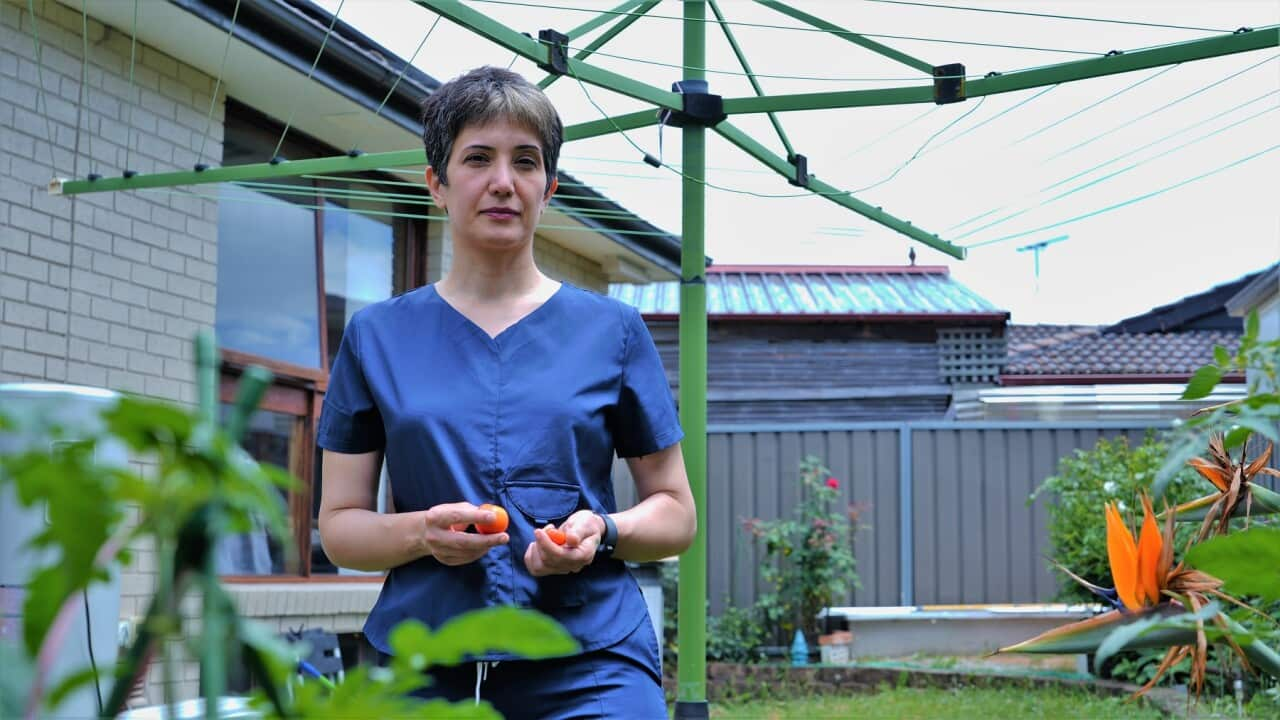Key Points
- Kyle Vander-Kuyp, a proud Worimi and Yuin man, represented Australia in the 110 metres hurdles at the Atlanta 1996 and Sydney 2000 Olympic Games.
- Lydia Williams, a proud Noongar woman, represented Australia in the Australian women’s national soccer team the Matildas from 2005 to 2024.
- E fa'afefea ona fa'aosofia e tagata ta'aalo a le atunu'u lagona o mitamitaga i tupulaga i le lumana'i?
O a ni lu'i na feagai ma tagata ta'aloga a le Atunu'u?
E fa'afefea ona fa'afeso'ota'i e ta'aloga le aganu'u ma le fa'asinomaga mo tagata Ausetalia?
O le a se talatuu ua tuua e tagata ta'aalo a le Atunu'u i taaloga a Ausetalia?
Aisea e taua ai le ta'aloga a le Atunu'u i le fa'asinomaga o le atunu'u o Ausetalia?
- I le tele o tausaga, e to'atele tagata ta'aalo a le First Nations ua ausia le tumutumuga o ta'aloga fa'apolofesa. O tagata e pei o le tagata muamua o le Olimipeka o Kyle Vander-Kuyp , tagata taalo soka faapolofesa Lydia Williams , ma le lauiloa o le pese o Cathy Freeman ua le gata ina fai ma sui o lo latou atunuu ae sa tauaveina foi le mitamitaga o a latou aganuu i luga o le tulaga o le lalolagi. O a latou faigamalaga e faamanatu mai ai ia i tatou o taaloga e le gata i le tagata lava ia ma le tuʻufaʻatasia - o se faʻavae mo le faʻaalia o le tagata lava ia, faasinomaga, ma le fesoʻotaʻiga.
E fa'afefea ona fa'aosofia e tagata ta'aalo a le atunu'u tupulaga i le lumana'i?
Mo le au ta'aloga a Ausetalia e pei o Lydia Williams ma Kyle Vander-Kuyp, o le matamata ia i latou na muamua atu na fesoasoani e fa'aola ai lo latou taumafai e manuia i le malae fa'atauva o ta'aloga fa'avaomalo.
"Ou te fiafia lava i taaloga ma fiafia i taimi uma i le lakapi ma taalo ma fai ma sui o loʻu atunuu. Ae o se mea moni lava o se aafiaga mataʻina ma o se galuega faʻataʻitaʻiga e fai ma sui o laʻu aganuu ma oʻu tagata, ma ia i ai se auala e mafai ai ona e sau mai soʻo se mea ma faʻataunuʻuina au miti, "o le tala lea a Lydia Williams, o se tamaitai Noongar na fanau i le itu i saute sisifo o Ausetalia i Sisifo. I le avea ai ma se sikoa, o ia o le tagata taalo sili ona umi i le au soka a tamaitai a Ausetalia, le Matildas.
O Lydia na fai ma sui o Ausetalia i ta'aloga e lua o le Olimipeka, e lima ta'aloga Ipu a le Lalolagi ma ono ta'aloga Ipu a Asia ma o lana ta'aloga ta'aloga ua ave ai o ia i le lalolagi atoa.
"Ou te manatu o le 'au na tuʻuina atu ia te aʻu ma laʻu 'au, o tagata uma e matua eseese lava talaaga ae o le mea e tasi na matou ioe uma o le matou mananao e tuua le taaloga e sili atu nai lo le taimi na matou faatoa taunuu ai i ai," o le tala lea a Lydia.
SYDNEY, AUSTRALIA - JUNE 03: Lydia Williams, goalkeeper of Australia is presented with a gift from Evonne Goolagong Cawley before the international friendly match between Australia Matildas and China PR at Accor Stadium on June 03, 2024 in Sydney, Australia. (Photo by Matt King/Getty Images) Credit: Matt King/Getty Images
O le ala i ta'aloga maualuluga e le'i aunoa ma ni fa'alavelave. O fa'afitauli o le fa'asinomaga, fa'atusa, ma le tutusa ua fa'ata'atia ai le poto masani o tagata ta'a'alo a le Atunu'u. Ua toe manatua e Lydia le fusuaga mo le tutusa o totogi ma le aloaia i le lakapi a tamaitai.
"I laʻu galuega atoa, sa fai a matou sikoa i mea matou te mananaʻo ai e tutusa le totogi i tamaloloa. Ua mafai ona matou faʻaalia le fuʻa Aboriginal i se Olimipeka. O lea ou te manatu o le 'au o se vaega autasi e talepe pa ma faʻatagaina tagata e tu atu mo mea latou te talitonu i ai."
O Kyle Vander-Kuyp na fai ma sui o Ausetalia i ta'aloga faigata i Ta'aloga Olimipeka e lua, Ta'aloga a le Taupulega ma le tele o ta'aloga siamupini o le lalolagi.
Na ia talanoa e uiga i le faʻatautaia o lona faʻasinomaga o se tamaititi vaetama e toe fesoʻotaʻi ma lona talatuu Worimi ma Yuin mai le talafatai o New South Wales.
O lona folasaga o le tamaitiiti i taaloga na ofoina atu ia Kyle se auala e faaalia ai le tagata lava ia ma se lagona o le sootaga i se vaega.
"O le vaetamaina i le lima vaiaso o le matua, o se tasi o oʻu luʻitau muamua o le taumafai e galue, Tina ma Tama, aisea ua ese ai aʻu ia te oe? Ae faʻafefea ona ese loʻu lanu paʻu? Masalo o loʻu luʻitau muamua lena, o le vaetamaina ma galue i lena faasinomaga, "o le tala lea a Kyle.
A o taumafai Kyle e malamalama atili i lona lava faasinomaga, na faamalosia e ala i le faamalosiauga mai ona matua ma uo, o lana taumafaiga lea i Little Athletics—o se polokalama e faailoa atu ai i tamaiti le tele o taaloga eseese o taaloga, lea na tuu ai o ia i se ala o le a mulimuli ane vaaia ai o ia e fai ma sui o Ausetalia.
E ui lava i ia luitau, o tagata taaalo uma e lua - e pei o le toatele na muamua atu ia i latou - na liua faigata e avea ma suauu mo le ausia, e faʻaalia ai o taaloga e mafai ona avea ma meafaigaluega mo le faʻamalosia.
Kyle Vander-Kuyp with his adoptive mother Patricia Vander-Kuyp and his birth mother Susan Dawson - Image supplied by Kyle Vander-Kuyp.
E fa'afefea ona fa'afeso'ota'i e ta'aloga le aganu'u ma le fa'asinomaga mo tagata Ausetalia?
Mo tagata ta'a'alo a le Atunu'u, o ta'aloga e sili atu nai lo le tauvaga - o le fa'aaliga fa'aleaganu'u. O potu loka e faʻaalia ai fuʻa Aboriginal ma Torres Strait Islander, ma tagata taʻalo e faʻaalia ma le mitamita measina i luga o le malae, o loʻo faʻaalia ai le auala e faʻaleleia ai e taʻaloga se lagona o le auai.
Na toe manatua e Kyle upu a le alii sili o le AFL o Maurice Rioli: “Ou te manatua lelei lava i le amataga o le aoga tulagalua na o le vaai atu i tagata e pei o Lionel Rose, Evonne Goolagong, ma sa ou laki lava i le sau o se tagata Aboriginal footy i la’u aoga, o Maurice Rioli, ma sa ia faasoa mai lana tala o se tagata taalo vae, ae sa faasoa mai foi lona tupuaga Aboriginal ma faapea mai, na ia tosoina a’u i totonu o le potu a le aufaigaluega. o se tulaga le lelei o le avea ma Aboriginal, o se tulaga lelei ma e te iloa, e tatau ona e faʻaaogaina.”
O ia fa'amaoniga e fa'aalia ai le loloto o le feso'ota'i o ta'aloga ma fa'asinomaga fa'aleaganu'u, e maua ai le va'aia ma le fa'amaualuga.
O Kyle na fai ma sui o Ausetalia i Taaloga a le Commonwealth i le 1990 i Aukilani i Niu Sila.
"Sa ou laki i le i ai i lena 'au ma Cathy Freeman ma sa ma talavou uma, o lea e 16 tausaga le matua o Cathy ma Kyle e 18 tausaga, ma ou te manatu o le taimi muamua lena e te iloa ai lou faasinomaga ma e te iloa o aʻu o se Ausetalia ma o loʻo ou ofuina lanu meamata ma auro, ae o aʻu o se tagatanuu moni o Ausetalia ma e te faia foi lena mea mo oe lava Ausetalia ma le tala faasolopito. tagata.”
O le a se talatuu ua tuua e tagata ta'aalo a le Atunu'u i taaloga a Ausetalia?
E tumau ma loloto le talatuu a tagata ta'aloga a le Atunu'u. Na latou fa'aosofia tamaiti i nu'u mamao, tau mo le tutusa i totogi ma sui, ma fa'aalia e mafai e fa'asinomaga ma measina ona nofo fa'amaualuga fa'atasi ma lanu o le atunu'u.
Ua matauina e Lydia Williams le taua o tamaitai talavou o le First Nations i aso nei e vaai i ni faataitaiga lelei i le lakapi: “O le taimi nei o loo i ai le toatele o tamaitai o le First Nations i le lakapi... e mafai e tamaiti ona fesootai atu ia i latou, o i latou o a latou faataitaiga.”
Mo Kyle, o taimi o le aloaia mai aiga ma nuu—o le faalogo atu na ia musuia isi—na faamalosia ai le malosi e suia ai taaloga.
“E te toe fo’i mai e taumafai e fai se olaga masani e aunoa ma le avea ma se tagata ta’a’alo fa’apitoa i aso uma, ae o le alu atu i nu’u mamao, ae fai mai aunties, grandmas, toeaina ma tamaiti e, ua matou va’ai ia te oe i luga o le TV ma ua e fa’aosofia ai i matou.
Kyle Vander-Kuyp near Uluru – Image supplied by Kyle Vander-Kuyp.
Aisea e taua ai le ta'aloga a le Atunu'u i le fa'asinomaga o le atunu'u o Ausetalia?
O tagata ta'aalo a Ausetalia e sili atu nai lo le manuia o le tagata lava ia. Latou te fa'aalia le maufetuuna'i, fa'aaofia, ma le fa'amaualuga fa'aleaganu'u. O lo latou i ai i tulaga o le lalolagi ua tuua ai se faailoga e le mafaagaloina i le vaaiga a Ausetalia ia te ia lava - o se malo ua faamalosia e ona tagata o Malo Muamua ma a latou mea na ausia.
Mai ta'aloga ta'aloga e o'o atu i tauvaga a le lalolagi, o lo'o fa'aauau pea ona fa'atupuina e tagata ta'a'alo a le atunu'u le tu ma aga ta'aloga, ma fa'amaonia ai o lo'o tumau pea le ta'aloga o se tasi o ta'avale sili ona malosi mo le lotogatasi, fa'asinomaga, ma musumusuga.
Mo Lydia Williams, o lana malaga ta'aloga e fai ma sui o lona atunu'u ma le aganu'u na fa'afiafiaina e ana 'au. Sa latou lagolagoina, fia iloa lona olaga o se tamaitai o le First Nations ma taulai atu i le faatumauina o se vaega autasi e taliaina le eseesega.
"Ia te aʻu, e taua tele le avea ma sui o loʻu atunuu ma laʻu aganuu. A matou ofuina le tumutumu, o loʻo i ai le fuʻa a Ausetalia ma faʻailoga i luga, ae o le mea e sili ona taua, o se 'au e matua tamaoaiga i aganuu. I totonu o le matou potu sui, o loʻo i ai le fuʻa Aboriginal ma Torres Strait Islander. O lea o se 'au e faʻaosofia ai le tele o le aofia ma le faʻamaualuga e fai ma sui o Lydia.
Mai le fetu soka faavaomalo i le fai suiga, o Lydia Williams o loʻo faʻamoemoe e faʻaauau le aʻoaʻoina, ma faia suiga mo le lelei.
“Ou te manatu o se mea fiafia tele i le taimi nei ona o le toatele o tamaitai o le First Nations i le lakapi, e mafai e tamaiti laiti ona latou iloa ma mafai ona latou mauaina, o latou o latou faʻataʻitaʻiga,” o le tala lea a Lydia.
Fa'asoa pe mulimuli i le Australia Explained podcast mo nisi fa'amatalaga taua ma fautuaga e uiga i le nofoia i lou olaga fou i Ausetalia.
E i ai ni au fesili po'o ni manatu autu? australiaexplained@sbs.com.au
